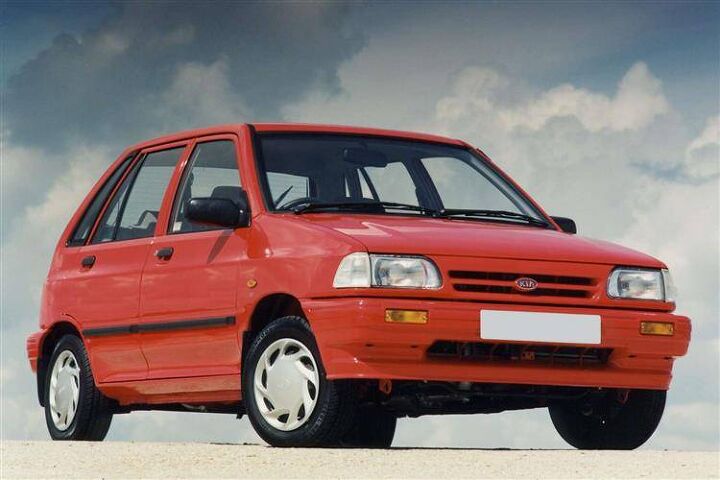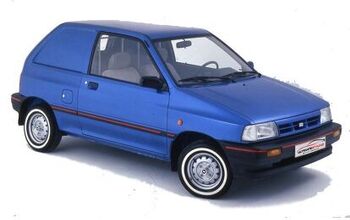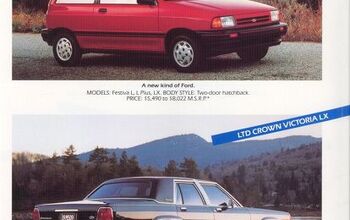Rare Rides Icons: The Ford Festiva, a Subcompact and Worldwide Kia by Mazda (Part II)

We return to our Rare Rides Icons coverage of the Ford Festiva today. An important world vehicle for the likes of Ford, Mazda, Kia (and eventually many others), the Festiva arrived at a time when rear-drive subcompacts were being replaced by much more efficient models that were front-drive. And the Mazda-designed Festiva was certainly more efficient and more front-drive than the Fiesta it replaced.
We covered the Festiva’s boxy, simple styling in our last entry, so today we jump straight into its platform and mechanicals. In 1981, Mazda changed the way it named its platforms. It assigned two-letter codes that were used for the fifth and sixth characters in VINs on Mazda-produced vehicles from the 1981 model year onward. Mazda uses this platform classification system today.
From the start, all letter coding with a D at the front represented a subcompact car that was front-wheel drive. The Festiva was assigned DA, as the first such car Mazda ever created. The DA had a short wheelbase of just 90.4 inches. The overall length for the Festiva at debut was 136.8 inches, with an overall width of 63.2 inches. Festiva reached 57.5 inches in height and had a weight of between 1,540 and about 1,720 pounds dependent on equipment and body style.
With a transverse engine layout, the front-drive Festiva used an independent front suspension with struts, coil springs, and a sway bar. The rear suspension was a torsion beam design. As one might expect, the Festiva’s engines were all Mazda units that hailed from the B family. The B was new at the time, and through its many variations was in production between 1985 and 2005. Notably, the engine design was non-interference, which meant the engine wasn’t lunched in the event of a timing belt failure. An important feature when running a car on a tight budget.
The first three engines to debut in the B lineup were all used in the Festiva. The most basic was the B1, a tiny 1.1-liter inline-four that had eight valves and was available only in SOHC guise. This most basic of engines was limited to use from 1987 to 1989 and was only used in the European and Asian markets. Kia would later use this engine in the Sephia.
Many people were interested in a BJ. The mid-level engine had 1.3-liters of displacement, with 16 valves and the all-important DOHC and single-point fuel injection. Only Japanese market Festivas used the BJ, and only in particularly sporty trims. The 1.3 was good for 87 horsepower.
Finally, the largest Festiva engine on offer was the B3. Slightly larger than the BJ’s 1,290 cc displacement, the B3 was 1,324 cc. It was offered only in SOHC guise and was available in the Festiva as well as Mazda’s larger Familia, the Ford Laser, and the successor to the Festiva the Aspire. Initially, the B3 was carbureted, but it was later developed further and received fuel injection. With either fuel distribution type, it had 63 horsepower. In the Nineties, the B3 was updated and enhanced, which added 10 horsepower to its rating. The B3 lived until 2005 in the Kia Rio, and until 2014 in Kia’s Pride.
Speaking of Pride, that’s what Kia called their version of the Festiva. The Pride was assembled locally in South Korea from the start, and the market was one of the first to start its production. Assembled under license, production started in 1986 for the 1987 model year.
Australia and Europe received the Festiva under its most accurate identity, as the Mazda 121. Sales for those markets started in 1987 as well. The Mazda 121 was a short-lived model, however, and after 1991 the 121 turned into the Ford Festiva on the Australian continent. In Europe, the 121 became the Kia Pride.
The thing to keep in mind with the Festiva: At its base, it was a Ford product request, and though Mazda handled the project themselves it was Ford calling the shots when Festiva went on sale. And so it was that in February 1986 the Mazda was launched in its home market of Japan, as the Ford Festiva. The hatchback was not available as a Mazda in Japan.
Japanese Festiva trims in its launch year included L, L Special, S, Ghia, and Canvas Top. Initial trims were supplemented later in 1986 for the ’87 model year by the GT and GT-X, which used the aforementioned DOHC engine. The Festiva was available through Ford’s Japanese dealership arm, called Autorama.
Though the cars for the Japanese market were produced in Japan and wore Ford badges, the Festivas for the North American market were produced in South Korea alongside the Kia Pride. North Americans had to wait a bit for the Festiva, as sales didn’t start in the US until late in ’87 for the 1988 model year. Canadian sales were even later, as the Festiva appeared there in January of 1989. To aid in distribution, the Festiva was also available at Mercury dealerships in Canada.
Unlike other markets, the North American Festiva was limited to one engine, the 1.3-liter B3. There were just three trim levels at introduction: L, L Plus, and LX. As commenters pointed out in our last entry, the way to tell the LX apart was via its luxurious rear wiper.
But the LX was upgraded in other ways, in that it was the only one to have a tilt steering wheel and a tachometer. It was truly the days of the basic subcompact car, as unless the LX was selected there were no alloy wheels, no interior mirror adjustments, and no cloth on the seats (only vinyl). Want a cassette player? You’d need to spring for the LX. The LX also featured a five-speed manual, with other trims represented by a four-speed. Those who avoided shifting themselves found their driving experience punctuated by a three-speed Mazda automatic.
It’s interesting to consider the market differences between the Festiva of Japan and the North American one. No DOHC engine, no sports trims with body kits, no canvas roof! It’s almost like Ford had to suppress the Festiva’s appeal so it didn’t conflict with other important small cars in the lineup, like the Escort.
While we’re on the topic of market differences, we need to cover the other markets that produced various versions of the Festiva for a long time. Aside from Mazda’s production (through 1992) and Kia’s (through 2000), there were three other major licensed manufacturers of the Festiva. In 1993 SAIPA of Iran began production of the Festiva under its own branding and built them in Iraq. In China, the Dongfeng Yueda Kia joint venture began its production in 1997. Finally, AAV joined the club in 1998 with Egyptian production.
It turned out AAV had the shortest interest in the Festiva, as it built the hatchback only through 2002. Dongfeng continued its manufacture through 2003. But SAIPA took the cake, as it produced various versions of the 1986 design through 2020. SAIPA called the Festiva a 111, 131, 132, and 141. Then they made a pickup truck out of it and called it 151. It also had some formal names, like Pride, Saba, and Nasim. Chinese production saw the Festiva rebranded as the Guangtong GTQ5010X, as the Chinese subcompact customer enjoys a long model name.
Through its various assembly locations, the Festiva was built at one factory in Japan, two in South Korea, and two in China. It was also built in the aforementioned Iran and Iraq, as well as Egypt, the Philippines, Taiwan, and Venezuela.
A tiny and yet very well-traveled car. We’ll talk about all the variations of the Festiva in our next installment. We’ll also cover the refreshes and updates that happened over its first generation.
[Images: Ford, Mazda, Kia, SAIPA]

Interested in lots of cars and their various historical contexts. Started writing articles for TTAC in late 2016, when my first posts were QOTDs. From there I started a few new series like Rare Rides, Buy/Drive/Burn, Abandoned History, and most recently Rare Rides Icons. Operating from a home base in Cincinnati, Ohio, a relative auto journalist dead zone. Many of my articles are prompted by something I'll see on social media that sparks my interest and causes me to research. Finding articles and information from the early days of the internet and beyond that covers the little details lost to time: trim packages, color and wheel choices, interior fabrics. Beyond those, I'm fascinated by automotive industry experiments, both failures and successes. Lately I've taken an interest in AI, and generating "what if" type images for car models long dead. Reincarnating a modern Toyota Paseo, Lincoln Mark IX, or Isuzu Trooper through a text prompt is fun. Fun to post them on Twitter too, and watch people overreact. To that end, the social media I use most is Twitter, @CoreyLewis86. I also contribute pieces for Forbes Wheels and Forbes Home.
More by Corey Lewis
Latest Car Reviews
Read moreLatest Product Reviews
Read moreRecent Comments
- Kmars2009 I rented one last fall while visiting Ohio. Not a bad car...but not a great car either. I think it needs a new version. But CUVs are King... unfortunately!
- Ajla Remember when Cadillac introduced an entirely new V8 and proceeded to install it in only 800 cars before cancelling everything?
- Bouzouki Cadillac (aka GM!!) made so many mistakes over the past 40 years, right up to today, one could make a MBA course of it. Others have alluded to them, there is not enough room for me to recite them in a flowing, cohesive manner.Cadillac today is literally a tarted-up Chevrolet. They are nice cars, and the "aura" of the Cadillac name still works on several (mostly female) consumers who are not car enthusiasts.The CT4 and CT5 offer superlative ride and handling, and even performance--but, it is wrapped in sheet metal that (at least I think) looks awful, with (still) sub-par interiors. They are niche cars. They are the last gasp of the Alpha platform--which I have been told by people close to it, was meant to be a Pontiac "BMW 3-series". The bankruptcy killed Pontiac, but the Alpha had been mostly engineered, so it was "Cadillac-ized" with the new "edgy" CTS styling.Most Cadillacs sold are crossovers. The most profitable "Cadillac" is the Escalade (note that GM never jack up the name on THAT!).The question posed here is rather irrelevant. NO ONE has "a blank check", because GM (any company or corporation) does not have bottomless resources.Better styling, and superlative "performance" (by that, I mean being among the best in noise, harshness, handling, performance, reliablity, quality) would cost a lot of money.Post-bankruptcy GM actually tried. No one here mentioned GM's effort to do just that: the "Omega" platform, aka CT6.The (horribly misnamed) CT6 was actually a credible Mercedes/Lexus competitor. I'm sure it cost GM a fortune to develop (the platform was unique, not shared with any other car. The top-of-the-line ORIGINAL Blackwing V8 was also unique, expensive, and ultimately...very few were sold. All of this is a LOT of money).I used to know the sales numbers, and my sense was the CT6 sold about HALF the units GM projected. More importantly, it sold about half to two thirds the volume of the S-Class (which cost a lot more in 201x)Many of your fixed cost are predicated on volume. One way to improve your business case (if the right people want to get the Green Light) is to inflate your projected volumes. This lowers the unit cost for seats, mufflers, control arms, etc, and makes the vehicle more profitable--on paper.Suppliers tool up to make the number of parts the carmaker projects. However, if the volume is less than expected, the automaker has to make up the difference.So, unfortunately, not only was the CT6 an expensive car to build, but Cadillac's weak "brand equity" limited how much GM could charge (and these were still pricey cars in 2016-18, a "base" car was ).Other than the name, the "Omega" could have marked the starting point for Cadillac to once again be the standard of the world. Other than the awful name (Fleetwood, Elegante, Paramount, even ParAMOUR would be better), and offering the basest car with a FOUR cylinder turbo on the base car (incredibly moronic!), it was very good car and a CREDIBLE Mercedes S-Class/Lexus LS400 alternative. While I cannot know if the novel aluminum body was worth the cost (very expensive and complex to build), the bragging rights were legit--a LARGE car that was lighter, but had good body rigidity. No surprise, the interior was not the best, but the gap with the big boys was as close as GM has done in the luxury sphere.Mary Barra decided that profits today and tomorrow were more important than gambling on profits in 2025 and later. Having sunk a TON of money, and even done a mid-cycle enhancement, complete with the new Blackwing engine (which copied BMW with the twin turbos nestled in the "V"!), in fall 2018 GM announced it was discontinuing the car, and closing the assembly plant it was built in. (And so you know, building different platforms on the same line is very challenging and considerably less efficient in terms of capital and labor costs than the same platform, or better yet, the same model).So now, GM is anticipating that, as the car market "goes electric" (if you can call it that--more like the Federal Government and EU and even China PUSHING electric cars), they can make electric Cadillacs that are "prestige". The Cadillac Celestique is the opening salvo--$340,000. We will see how it works out.
- Lynn Joiner Lynn JoinerJust put 2,000 miles on a Chevy Malibu rental from Budget, touring around AZ, UT, CO for a month. Ran fine, no problems at all, little 1.7L 4-cylinder just sipped fuel, and the trunk held our large suitcases easily. Yeah, I hated looking up at all the huge FWD trucks blowing by, but the Malibu easily kept up on the 80 mph Interstate in Utah. I expect a new one would be about a third the cost of the big guys. It won't tow your horse trailer, but it'll get you to the store. Why kill it?
- Lynn Joiner Just put 2,000 miles on a Chevy Malibu rental from Budget, touring around AZ, UT, CO for a month. Ran fine, no problems at all, little 1.7L 4-cylinder just sipped fuel, and the trunk held our large suitcases easily. Yeah, I hated looking up at all the huge FWD trucks blowing by, but the Malibu easily kept up on the 80 mph Interstate in Utah. I expect a new one would be about a third the cost of the big guys. It won't tow your horse trailer, but it'll get you to the store. Why kill it?










































Comments
Join the conversation
Couple things: 1) never knew about the SAIPA 151. Mind blown. 2) never knew that these were never sold in Japan as a Mazda 121, or that Ford sold them there as a Festiva. 3) I still see these now & then. I was a true Honda freak back then, but I still admire that these are simple and to the point. College friend's girlfriend had one and said it was a hoot to drive. 4) the dealer in my rural east coast hometown would sell these as L Plus or LX models with numerous upgrades like stereos, stripes, flip up sunroofs or sometimes fabric roofs like a Renault R5, etc. 5) I would much rather have one of these than a new Mini, Smart, etc. It's an excellent city car for someone who doesn't need a daily car.
its time to bring back a cheap ragtop as an option